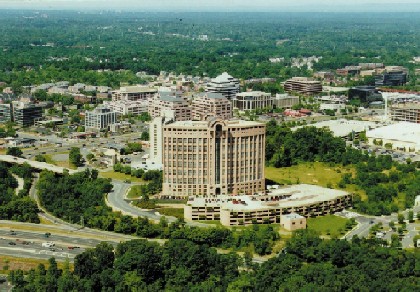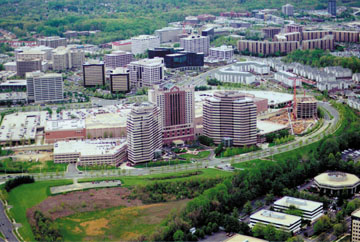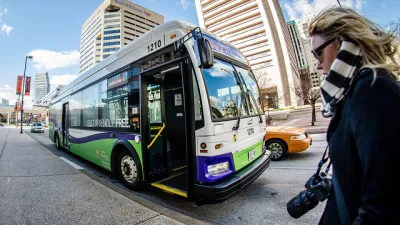First, let me begin by introducing myself. I am Parris Glendening, and I serve as the president of the Smart Growth Leadership Institute in Washington, D.C., which is part of Smart Growth America. From 1995-2003, I was Governor of Maryland, and for more than 20 years before that I served at various levels of local and county government. I am excited about being part of the network of contributors here at Planetizen and participating in the discussion.---In 1956 Pres. Dwight Eisenhower shepherded the Interstate Highway into existence, fulfilling a decades-long aspiration to link the nation with highways that could move both people and materiel as efficiently as those he had seen in Germany. Later, he would warn us against the military-industrial complex, but with a bit more foresight he might have warned against the asphalt-industrial complex, as well.
---
In 1956 Pres. Dwight Eisenhower shepherded the Interstate Highway into existence, fulfilling a decades-long aspiration to link the nation with highways that could move both people and materiel as efficiently as those he had seen in Germany. Later, he would warn us against the military-industrial complex, but with a bit more foresight he might have warned against the asphalt-industrial complex, as well.
 Tysons Corner is a suburb of Washington, D.C., just outside the Beltway. The once-sleepy crossroads is now one of the main employment centers of the region, home to the equivalent of one-third of the office space in D.C. proper. Several years ago, the Washington Area Metropolitan Transit Authority and Virginia officials began planning a Metrorail extension through Tysons Corner and Fairfax County to Dulles Airport. But while the service was welcome, the plan to run it on an elevated track provoked a groundswell of opposition among business owners, citizens, and local leaders.
Tysons Corner is a suburb of Washington, D.C., just outside the Beltway. The once-sleepy crossroads is now one of the main employment centers of the region, home to the equivalent of one-third of the office space in D.C. proper. Several years ago, the Washington Area Metropolitan Transit Authority and Virginia officials began planning a Metrorail extension through Tysons Corner and Fairfax County to Dulles Airport. But while the service was welcome, the plan to run it on an elevated track provoked a groundswell of opposition among business owners, citizens, and local leaders.The core of the problem is a fundamental flaw in the system of funding at the FTA, which elevates short-term number-crunching over community impacts and long-term benefits.
 FTA officials told Kaine that switching to a tunnel would jeopardize the federal funding, even if Virginia found other sources to cover the more expensive, but longer-lasting tunnel option. Never mind that the tunnel would be far less disruptive to businesses and residents during construction, or that it would spur many times as much investment along the corridor, or that it would simply help make Tysons a more people-friendly place to be. It cost more, and that was the end of that.
FTA officials told Kaine that switching to a tunnel would jeopardize the federal funding, even if Virginia found other sources to cover the more expensive, but longer-lasting tunnel option. Never mind that the tunnel would be far less disruptive to businesses and residents during construction, or that it would spur many times as much investment along the corridor, or that it would simply help make Tysons a more people-friendly place to be. It cost more, and that was the end of that. www.smartgrowthamerica.org
www.sgli.org

Planetizen Federal Action Tracker
A weekly monitor of how Trump’s orders and actions are impacting planners and planning in America.

Restaurant Patios Were a Pandemic Win — Why Were They so Hard to Keep?
Social distancing requirements and changes in travel patterns prompted cities to pilot new uses for street and sidewalk space. Then it got complicated.

Maui's Vacation Rental Debate Turns Ugly
Verbal attacks, misinformation campaigns and fistfights plague a high-stakes debate to convert thousands of vacation rentals into long-term housing.

Boulder Eliminates Parking Minimums Citywide
Officials estimate the cost of building a single underground parking space at up to $100,000.

Orange County, Florida Adopts Largest US “Sprawl Repair” Code
The ‘Orange Code’ seeks to rectify decades of sprawl-inducing, car-oriented development.

Maui's Vacation Rental Debate Turns Ugly
Verbal attacks, misinformation campaigns and fistfights plague a high-stakes debate to convert thousands of vacation rentals into long-term housing.
Urban Design for Planners 1: Software Tools
This six-course series explores essential urban design concepts using open source software and equips planners with the tools they need to participate fully in the urban design process.
Planning for Universal Design
Learn the tools for implementing Universal Design in planning regulations.
Heyer Gruel & Associates PA
JM Goldson LLC
Custer County Colorado
City of Camden Redevelopment Agency
City of Astoria
Transportation Research & Education Center (TREC) at Portland State University
Camden Redevelopment Agency
City of Claremont
Municipality of Princeton (NJ)




























